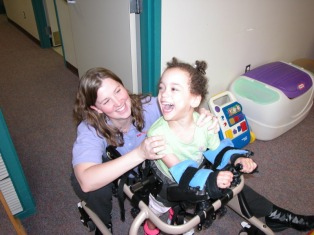Classification By Movement Disorder
(1) Spastic CP- Spastic muscles are tight and stiff, and have increased resistance to being stretched. They become overactive when used and produce clumsy movements. Normal muscles work in pairs: when one group contracts, the other group relaxes to allow free movement in the desired direction. Spastic muscles become active together and block effective movement. This muscular "tug-of-war" is called co-contraction. Spasticity may be mild and affect only a few movements, or severe and affect the whole body. The amount of spasticity usually changes over time. Therapy, surgery, drugs and adaptive equipment may help to control spasticity. Damage to the brain's cerebral cortex is generally the cause of spastic cerebral palsy.
(2) Athetoid CP- Athetosis leads to difficulty in controlling and co-ordinating movement. People with athetoid cerebral palsy have many involuntary writhing movements and are constantly in motion. They often have speech difficulties. Athetoid cerebral palsy results from damage to the basal ganglia in the midbrain. It was once common as a result of blood type incompatibility, but is now rarely seen.
(3) Ataxic CP- Ataxic CP is the least common form of cerebral palsy. People with ataxic CP have a disturbed sense of balance and depth perception. They usually have poor muscle tone (hypotonic), a staggering walk and unsteady hands. Ataxia results from damage to the cerebellum, the brain's major centre for balance and co-ordination.
(2) Athetoid CP- Athetosis leads to difficulty in controlling and co-ordinating movement. People with athetoid cerebral palsy have many involuntary writhing movements and are constantly in motion. They often have speech difficulties. Athetoid cerebral palsy results from damage to the basal ganglia in the midbrain. It was once common as a result of blood type incompatibility, but is now rarely seen.
(3) Ataxic CP- Ataxic CP is the least common form of cerebral palsy. People with ataxic CP have a disturbed sense of balance and depth perception. They usually have poor muscle tone (hypotonic), a staggering walk and unsteady hands. Ataxia results from damage to the cerebellum, the brain's major centre for balance and co-ordination.
| classification_by_movement_disorder.wma |
Source:
What is Cerebral Palsy? (2010). Retrieved June 24, 2010, from Ontario Federation of Cerebral Palsy: http://www.ofcp.on.ca/aboutcp.html

